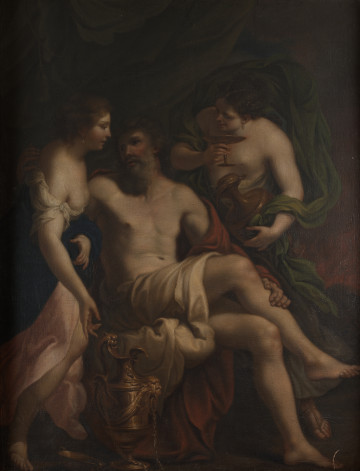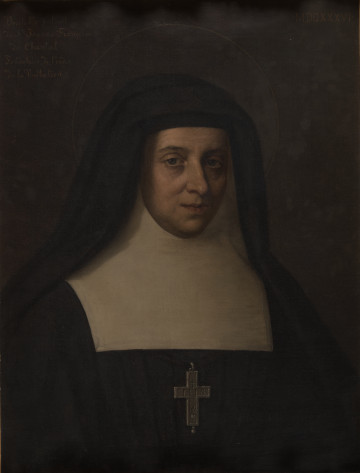
Our Lady with the Child, St. John and St. Joseph
17th century
Castle Museum in Łańcut
Part of the collection: Painting and drawing
The painting depicts a scene familiar from the New Testament Apocrypha. In the Gospels, we find only a mention of the fact that King Herod, having heard from the Three Magi about the birth of the Messiah in Bethlehem, ordered all the local boys (up to three years old) to be killed. St Joseph, Jesus’ guardian, was warned in a dream by an angel to go with Mary and baby Jesus to Egypt. The Gospels are silent about the journey itself, so artists, relying on the apocrypha, treated the subject quite freely. The scene of the flight to Egypt was a frequent subject of paintings. Usually they showed Mary seated with the Child on her knees and St Joseph, usually much older than Mary, standing behind her. The scene was usually set against a landscape (often a tree under which Mary is sheltered). The scene is accompanied by a donkey on which the Virgin Mary rides. St Joseph, as a heavily aged man is depicted slightly behind. The painter has additionally shown here the intimate moment after Jesus’ feeding (you can see Mary’s bare breast). The image of the Mother of God feeding the Child has been very popular since the Middle Ages. According to beliefs, having such an image at home protected against hunger. The infant is naked, so that the viewer viewing the image saw the body of Christ, and at the same time the very act of feeding points to His humanity (God and man). Tadeusz Kuntze (Konicz), known in Italy as Taddeo Polacco (born 1733 in Zielona Góra, died 1793 in Rome) was the court painter to Bishop Stanisław Załuski, who sent him to Rome to continue his education. After a nine-year stay in Rome, he went to Paris, and in 1757 returned to Krakow. After the death of his patron, Bishop Załuski, he settled in Rome, where he died. He achieved his greatest mastery in religious painting, introducing landscapes to his scenes and preferring a luminous range of colours (pinks and blues); towards the end of his life, he also painted genre scenes.
Author / creator
Dimensions
height: 108.5 cm, width: 94.5 cm
Object type
Painting and drawing
Technique
oil
Material
canvas
Origin / acquisition method
decyzja administracyjna
Creation time / dating
Creation / finding place
Owner
Castle Museum in Łańcut
Identification number
Location / status

17th century
Castle Museum in Łańcut

17th century
Castle Museum in Łańcut

2nd half of the 19th century
Castle Museum in Łańcut
DISCOVER this TOPIC
Castle Museum in Łańcut
DISCOVER this PATH
Educational path